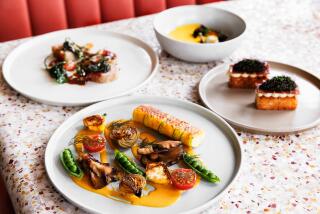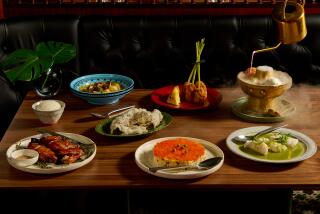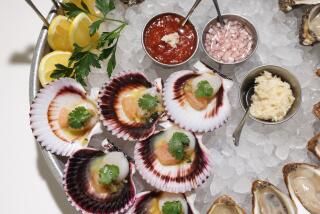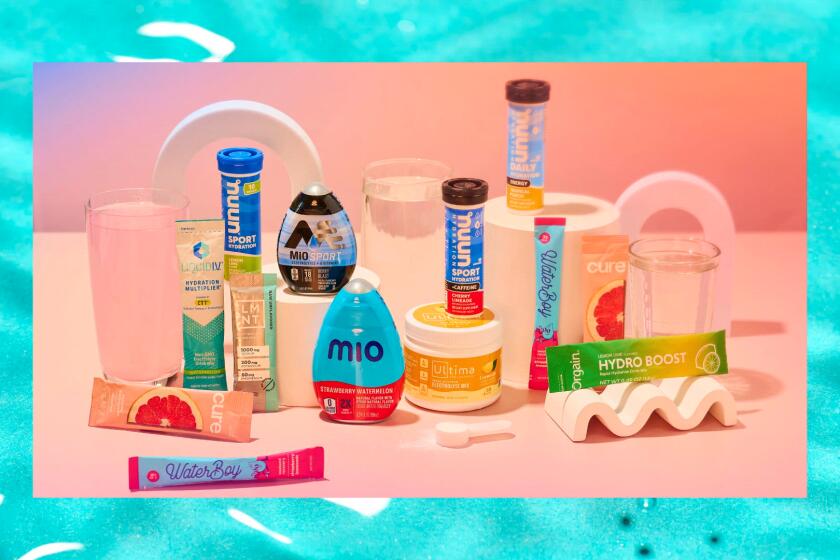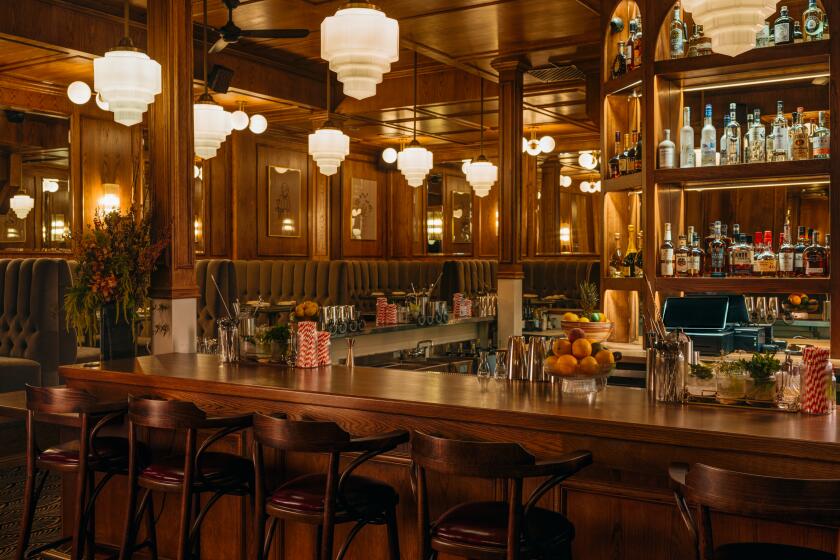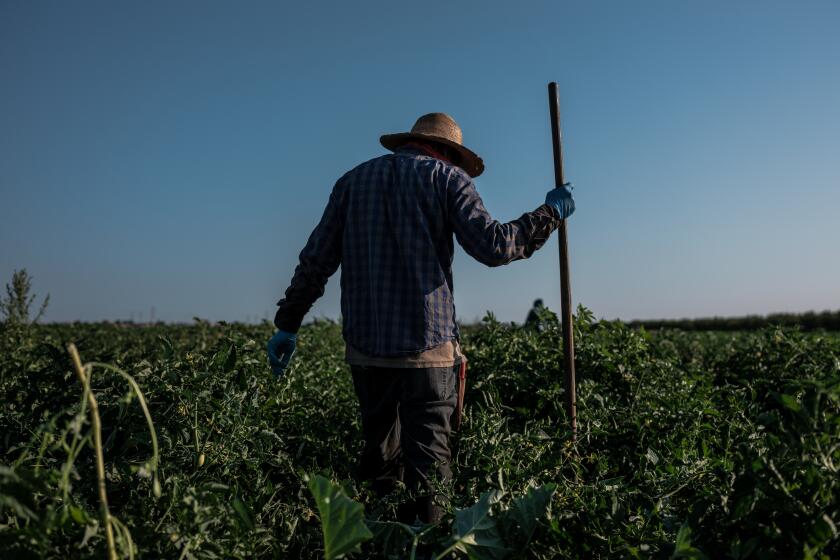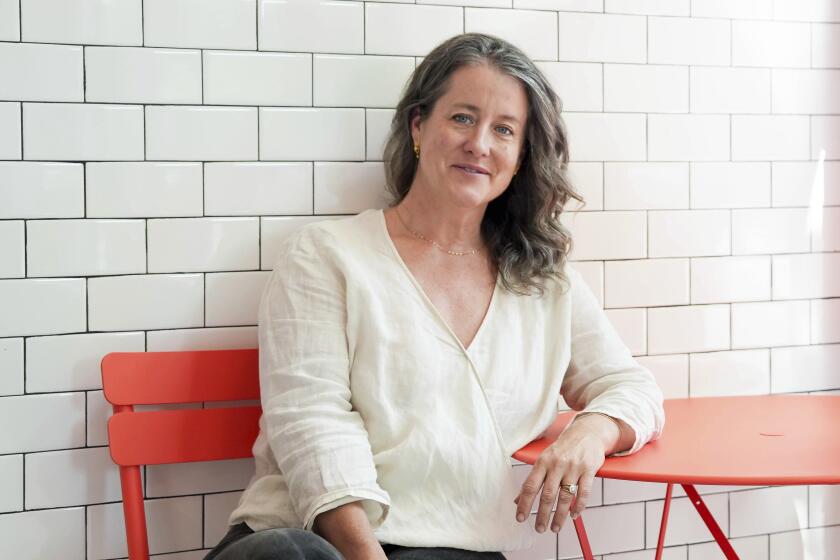Champagne’s Sparkling Moment
For years now, the nation’s consumption of sparkling wines has been flatter than a bad Brut.
But next year, it is a foregone conclusion that legions of novices who have never tasted sparkling wine--along with millions of champagne sophisticates--will pop for bottles of bubbly to ring in 2000.
Knowing this, or at least yearning for it, every sparkling wine maker worth her spit bucket is uncorking something special for the millennial countdown. There are hand-etched bottles, gold-embossed labels, boxes of exotic wood that will double as cigar humidors and--lest the hoopla blind everyone to the purpose of the exercise--some prized vintages inside those fancy packages.
“Every day I see something new for the millennium,” said Steve Wallace, owner of Wally’s, a West Los Angeles wine shop.
Seeking to create some urgency for an event that is still a year away--two, for the purists--a few winemakers are sounding an alarm. Procrastinators, they say, could face shortages of, or at least higher prices for, the good stuff if they don’t make selections months in advance. In some cases, that means buying fizz “futures”--paying in advance for bottles that will be delivered next summer or later.
Many wine writers and shop owners dispute the suggestion that shelves will be laid bare. But they acknowledge that some of the most prestigious offerings are likely to be hot, scarce commodities. In August, for example, Roederer, a French house, sold out its 2,000 limited-edition methuselahs (holding eight bottles and costing $2,000) and promptly broke the bottle’s mold. They are now selling in the “aftermarket” for as much as $6,000, Wallace said.
For wineries catering to the U.S. market, much is riding on this unique opportunity. Unlike premium table wines, which have enjoyed strong gains in recent years, sales of sparkling wine have been stagnant.
Shipments of U.S.-produced and imported sparkling wines peaked at 19 million cases in the mid-1980s when the economy was buoyant; as uncertainty crept in to the market and the overall economy, shipments tumbled. In recent years, the stubborn perception that sparkling wine is only for special occasions has held shipments to about 12.7 million cases annually. By volume last year, champagnes and sparkling wines had just a 6% share of the total U.S. wine market of 525 million gallons.
Vintners are hopeful that countless toasts at 21st century-welcoming parties will convince consumers that champagne should be sipped more commonly than at weddings and other festive occasions.
“This is so major, this millennium thing,” said Joy Sterling, whose family owns Iron Horse Vineyards in Sebastopol, Calif. “You’re looking at a minimum of three years of celebrations, thanks to Prince [‘Tonight we’re gonna party like it’s 1999’] and Arthur Clarke [author of ‘2001: A Space Odyssey’].”
At Korbel Champagne Cellars in Guerneville, millennial preparations began five years ago. The Sonoma County winery obtained the trademark for “The Official Champagne of the Millennium” and lobbied to become the authorized sparkling wine for all Times Square events during the next decade, forking over $10 million for the privilege.
Perrier-Jouet, known for its flowery bottles, has set aside juice from its high-quality 1995 vintage to fill 2,000 hand-numbered, gilded jeroboams--each equal to four bottles and priced at $2,000.
Reserve Belle Epoque Champagne comes with a deed entitling the buyer to a one-night stay and dinner for two at the winery’s sumptuous 18th century guest house in Epernay, France.
Never mind that the stroke of midnight on Dec. 31, 1999, does not usher in the 21st century, which really begins on the first day of 2001. It appears clear for now that even temporal sticklers will be unable to resist hoisting a flute or two along with their impatient or ill-informed brethren, once all those 9s morph into zeros.
As a result, sparkling wine houses are engaging in unprecedented fin de siecle hype.
Iron Horse, in Sonoma County, is offering futures in the form of a certificate, much like a stock certificate. The price for a commemorative jeroboam--hand-etched and adorned with silver paint and glitter--started at $350 a few months ago, then moved to $400 in November. It will rise to $450 after Jan. 1, ascending in $50 increments monthly after that. Delivery of the 1994 Brut (very dry sparkling wine) will be in November 1999. (At less momentous times, a bottle of Iron Horse retails for $25 to $45.)
So far, about 300 of 1,000 certificates have been sold.
Domaine Chandon, a Napa Valley winery owned by France’s Moet & Chandon, will soon release its specialty blend, predominantly from the 1992 harvest. The gold-bedecked label presents Cuvee 2000 “for those of you who missed Cuvee 1000 and don’t have the patience to wait for Cuvee 3000.”
French producer Ruinart has a $1,500 magnum (1 1/2 bottles) in a silver-caged bottle by Christofle that will serve as a decanter; the African walnut box is a humidor, complete with humidifier.
It is possible that economic or political malaise or a backlash to the overkill could burst the champagne makers’ bubble.
But it’s not likely. People will celebrate because it’s “an event that isn’t going to happen again in anyone’s lifetime,” said Eileen Fredrikson, of Gomberg, Fredrikson & Associates, a San Francisco research firm.
The idea, said winemaker Eileen Crane of Domaine Carneros, a French-owned house near Napa, “is to build repeat customers who fall in love with the wine.”
At Schramsberg, also in the Napa Valley, production has been boosted incrementally. “We have not banked our future on selling 50% more wine,” winemaker Mike Reynolds said.
By contrast, a huge push is on at Korbel, the nation’s largest producer of sparkling wines in the champagne style. The winery is increasing 1999 production by 200,000 cases, or 17%. And it has negotiated month-by-month tie-ins for next year with Dove chocolates, Delta Airlines, Royal Caribbean cruises, Fuji film and others. It also will soon unveil the “world’s largest champagne bottle,” a specially commissioned, handblown wonder from Germany that stands 4 feet, 6 inches tall.
“We’re promoting 12 months of the year starting in January 1999,” said Korbel President Gary Heck. For 1999, the winery has earmarked $28 million for advertising, more than double the typical spending.
Daniel Palmer, general manager of the Wine House, a West Los Angeles retailer, said he expects a doubling of champagne sales next year. Low-end buyers, he figures, “will step up for the millennium,” possibly creating a supply crunch in the $30-$50 range. (Typically, sparkling wines come in a wide range of prices--from $6 for a drinkable Spanish variety to $500 for a Dom Perignon or Krug Rose.)
For celebrity photographer Phil Ramey, a Los Angeles collector of vintage champagnes, Dec. 31, 1999, is an evening worthy of indulgence. In 1996, he paid $2,000 for one of the prized Roederer Cristal millennium bottles. Ramey plans to pick up the special package in Paris and carry it home on the plane. He will open it next New Year’s Eve with 15 friends on a small island off Miami.
“It’s an extravagance,” he said, “but it’s a once-in-a-lifetime situation, and I’m glad to have done it.”
(BEGIN TEXT OF INFOBOX / INFOGRAPHIC)
Glossary of Sparkling-Wine Terms
Beads: Slender strands of bubbles that slowly rise from the bottom of the glass.
Blanc de blancs: A white champagne made from white grapes.
Blanc de noirs: A white (often slightly pink) champagne made from red grapes.
Champagne: Wine made in the Champagne region of France and only with chardonnay, pinot noir and pinot meunier grapes and only in the methode champenoise tradition, which means that the second fermentation occurs in the bottle in which the wine will be sold.
Cuvee: The blend. A non-vintage champagne or sparkling wine is blended from several vintages to give complexity to the finished wine.
Extra dry: Though it seems odd to call a sweeter champagne “extra dry,” that is just what this term means.
Finish: The impression the wine leaves after being swallowed; usually, the longer the impression (or aftertaste), the better the wine.
Riddling: The daily turning of young bottles of champagne, performed automatically or, rarely, manually.
Source: Mumm Napa
More to Read
Eat your way across L.A.
Get our weekly Tasting Notes newsletter for reviews, news and more.
You may occasionally receive promotional content from the Los Angeles Times.
